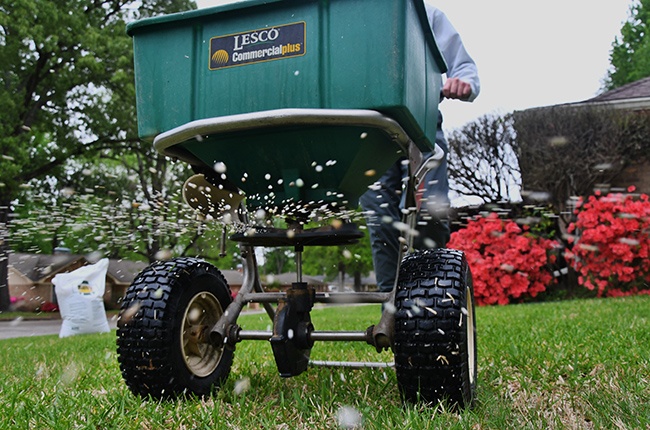
Springtime is a good time to prepare lawns for a healthy summer as warm-season grasses come out of dormancy and begin to green up, said a Texas A&M AgriLife Extension Service expert.
Dr. Becky Grubbs, AgriLife Extension turfgrass specialist, College Station, said lawn care is a multifaceted effort homeowners can tackle if they follow AgriLife Extension recommendations and invest the time to create healthy, thriving grasses.
“It’s impossible to make blanket recommendations for homeowners who want their lawn to perform to its potential,” she said. “But AgriLife Extension has an incredible amount of science-based information that can direct homeowners on most lawn care questions and concerns.”
AgriLife Extension has several online resources available to help homeowners establish and maintain turfgrass.
Aggie Turf has extensive information about caring for species including Bermuda grass, St. Augustine, buffalo grass, seashore paspalum and others.
The site also provides information regarding identification and treatment of common weeds and insect pests and publications that address specific weed, disease and pest issues.
Grubbs recommends homeowners contact their county’s AgriLife Extension agents for recommendations that meet their lawn’s needs according to local conditions.
Thatch
One thing all homeowners can check for is excess thatch – a layer of living and dead grass stems, roots, rhizomes and stolons, which are new plant growth that develops between the live green vegetation of a lawn and the soil surface. The thatch layer is composed of plant parts at various stages of decomposition, according to an AgriLife Extension publication.
Thatch can help provide a good growing environment for grasses, but excess thatch can prevent water and oxygen from reaching plant roots and create conditions for diseases, Grubbs said.
Core aerators or verticutters can be used to thin thatch, she said. Many professional landscapers can dethatch and aerate lawns, or machines can be rented at some lawn and garden retailers.
The AgriLife Extension publication for thatch management is available online.
“Roots need oxygen and water to survive, and microbes need oxygen to be productive to create healthy soil,” she said.
Fertilizer
Once past the window of a last frost, Grubbs said homeowners should ramp up their grasses’ access to nitrogen via fertilizers. The nitrogen requirements for grasses vary with species, but most warm-season varieties should receive nitrogen fertilizer every four to six weeks.
Bermuda grasses, for instance, can require moderate-to-high levels of fertilizer, she said.
“Bermuda grass needs approximately 1 pound of nitrogen per 1,000 square feet every four to six weeks between May and August, whereas buffalo grass, which is native to West Texas and typically low maintenance, needs less nitrogen over the growing season,” she said. “I would emphasize that homeowners need to strike a balance with their fertilizing, as too much fertilizer can be detrimental for the grass, the environment and their pocketbook.”
Water
Like fertilizers, grass species also require different amounts of water, Grubbs said.
“Making a recommendation on water is difficult because it varies so much with location, grass species and ever-changing environmental conditions,” she said.
AgriLife Extension has an online resource that provides evapotranspiration rates and watering needs based on current conditions for around 50 locations around the state.
Evapotranspiration, which is the rate water evaporates into the atmosphere by evaporation and by transpiration from plants, for some areas can be found by going to the site and clicking on the county or weather station nearest their lawn, she said. It will calculate how much water needs to be applied with the input of a little information.
Grubbs does recommend homeowners refrain from watering until grass shows initial signs of stress – such as reduced bounce-back.
“When you walk on your lawn and the leaves don’t immediately bounce back and your steps leave an indention – it’s time to water,” she said.
Typically, watering one to two times a week for a total of 1-2” of water when conditions are dry is plenty, she said. Moisture- or rain-sensing technology is a good way to avoid overwatering.
Grubbs recommends watering to reach a soil depth of 6 inches.
“That might take using a hand trowel to dig down and see how much time and water it takes,” she said.
Another resource that provides insight about proper lawn watering is available online.
Homeowners should also be aware of municipal water restrictions and recommendations, Grubbs said.
Grubbs said homeowners with sprinklers should also be mindful about their systems and check for leaks or faulty sprinkler heads and using water unnecessarily.
Water-wise individuals can learn how to test their sprinkler system from a video by AgriLife Extension’s Water University.
“It’s a good time to check systems or have a professional take a look at it,” she said. “A malfunctioning sprinkler head could mean too much water in one area or not enough in another.”
Weeds
Grubbs said the best way to fight weeds is by promoting warm-season grasses. Creating ideal conditions for specific warm-season grass varieties includes fertilizing and watering appropriately.
“The time for pre-emergents has passed, but we can do other things to help create ideal conditions for turfgrasses,” she said. “Turfgrasses can more easily outcompete weeds for resources when we reach the goal of a healthy, dense turf.”
Grass health will also depend on other conditions such as whether it is a high- or low-traffic area, the amount of shade or sun it receives, and mowing height, she said. Post-emergent herbicides, such as 2,4-D, work well against broadleaf weeds such as dandelions without hurting most turfgrass varieties, but they aren’t effective against clover and grassy weeds.
“Weed identification is very important when it comes to determining what the treatment options are,” she said. “Again, I would reference Aggie Turf publications or contact a local AgriLife Extension agent when there is a question.”
Mowing
Grass species will play the most significant factor in mowing height, and conditions such as rain and sun will direct frequency of cutting, Grubbs said.
“Homeowners should never take more than one-third of the plant’s mature height throughout the season,” she said. “The amount of shade or sun will also factor into how high the grass should be cut. The height should be raised about 50 percent for areas that are shady most of the time.”
The amount of foot traffic will also direct mower height, Grubbs said.
An AgriLife Extension publication on mowing practices at https://bit.ly/2H2eNrx can direct homeowners on cutting height, mowing equipment and frequency for several grass species in lawns, athletic fields and golf courses.
“Once homeowners establish what they need to do to provide the right environment and conditions for their lawns to thrive, lawn care won’t seem like such a daunting task,” Grubbs said. “Most things will become a routine that will be repeated each year and growing season, and AgriLife Extension publications, resources and staff are available for things that pop up.”
###
This story by Adam Russell originally appeared in AgriLife Today.





